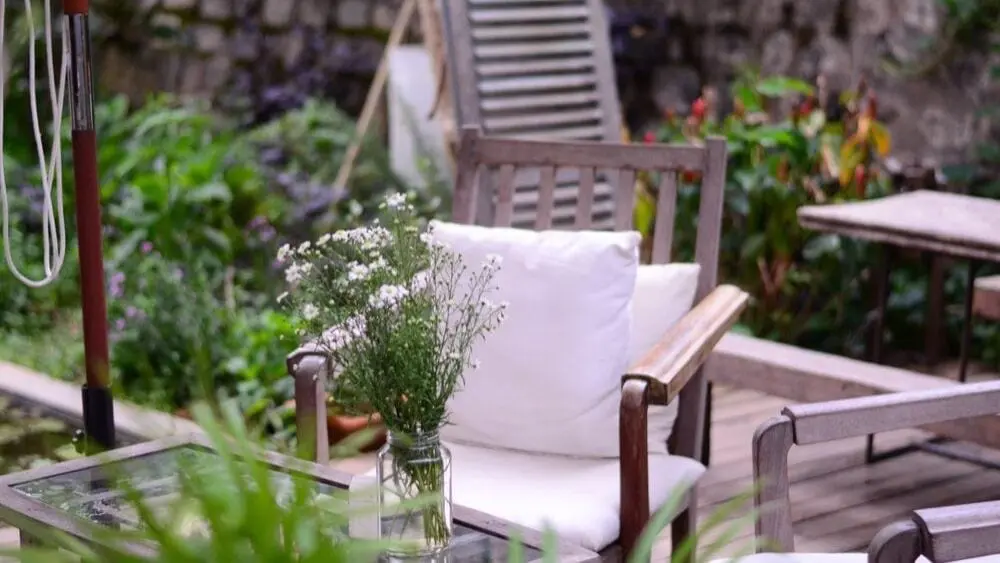
Just saying the words “outdoor living room” conjures images of relaxing al fresco, feet dangling over the side of a chair, a cold iced tea on a table nearby. While most people associate an outdoor living room with summertime or somewhere with eternal sunshine like Florida, having a fresh-air retreat increases the usable living space of your home while also adding resale value — regardless of the time of year when you’re likely to use it most. If you have a large family, the extra space also will undoubtedly come in handy whenever someone needs privacy or a little space to themselves.
The best outdoor living rooms have some cover from the elements and are adjacent to or near the indoor living room or kitchen. This makes it easy to bring food, drinks, and games in and out with ease. Below are a few more tips and guidelines to help you create your version of the perfect outdoor living room. Unlike a patio or deck, making the space feel as homey as the inside of your home is what gives it the feeling of an outdoor living room — so don’t hesitate to put your own stamp on it.
1. Consider the Climate Where you Live

Defining the space designated for your outdoor living room is key, and the weather where you live merits plenty of consideration. Unlike indoor living rooms, having four walls isn’t necessary when creating an outdoor living room, but a ceiling is a must to safeguard from the elements and ensure a more pleasant temperature away from the sun’s rays. Sliding glass walls are one way to have the best of both worlds, connecting indoor and outdoor spaces on command.
Having an outdoor fireplace might make perfect sense if you live near mountains, but in a state like Florida, outdoor ceiling fans will likely get much more use. Many of today’s outdoor ceiling fans are designed to cool spaces as large as 400 feet. Misters are another affordable way to make an outdoor living room in a warm climate more comfortable. Many 40-foot systems are easy to install yourself and cost less than $100. They emit a light mist that’s just enough to cool you down without dampening or destroying furniture. Whatever you choose to do, understanding any weather-related limitations you may have is key to creating an outdoor living room that will function well at any time of year.
2. Choose Furnishings Wisely

It’s a myth that you can only place outdoor furniture outdoors. If your space is covered and protected from the elements, you can move even indoor furniture outdoors. An old console, for example, is a great spot for setting out a BBQ buffet or a bar for a garden party. Those who love to entertain might enjoy a rolling bar cart they can employ as needed. When these furnishings aren’t in use, potted plants will keep them looking like they’re a part of the outdoor living space.
When it comes to outdoor seating, the number one question to ask yourself is, “What do you intend to use your outdoor living room for?” If it’s a conversation nook you’re after, a set of four comfy club chairs around a large coffee table or outdoor fire pit might be a better choice than an outdoor sofa or sectional. Love to entertain? Then ample seating is a must, and a sectional might be just the trick to anchor the space. If you’re an avid reader wanting an outdoor spot where you can curl up with a book or do your daily meditations, you’ll need floor space for your mat and a comfy chair or swing with side compartments for books, like this Swingasan chair. If you’re the type who loves to nap outdoors, a day bed might be an even better choice. Whatever you do, resist the urge to buy online without first testing the seating or reading reviews. It’s hard to know if something is truly comfortable without doing either, and an outdoor living room will be useless if it’s not comfy and lounge-worthy.
When it comes to furniture fabrics, UV-resistant materials, such as those from Sunbrella, are ideal, especially if you live in a particularly sunny part of the country. Even during the winter months, the sun’s rays can wreak havoc on furnishings, fading fabric colors, and even prompting fraying in extreme circumstances.
If you have young children, that will be a major consideration, too. Double-duty furniture that works as storage or seating, for example, is great for families. The same goes for homeowners who love to entertain. A side table that secretly hides an ice bucket with cold drinks, such as this one from Pottery Barn, is just one example.
3. Light up the Space Right

To create the feeling of an actual living room, create layers of light. A combo of outdoor and landscape lighting will create a warm, cozy atmosphere that makes it easy and safe to enjoy the space day or night. Many ceiling lights, ceiling fans with lights, and chandeliers are perfectly suitable for outdoor living rooms and can serve as the primary source of light. Wall-mounted lights near doorways help welcome you in and out, while step lights are important for stairs and any uneven pathways that lead to outdoor living rooms. Trendy string lights have a whimsical effect that’s perfect for an outdoor living room, while hurricane lamps and lanterns create a more romantic mood.
The good news is there have never been more outdoor lighting options available than there are now. Even solar lights aren’t as expensive these days, and you can find them in post, deck-mounted, and tabletop models. Whatever you choose, consider dimmers so you can adjust the light based on the changes in natural light. You’ll also want to bear UL listings in mind, too. There are two UL listings for outdoor lighting: damp location and wet location. The former should only be used in covered areas where they’re not exposed to rain or any type of water. UL fixtures deemed suitable for wet locations are best for those living rooms where there may be drips or splashes from time to time, such as open-air patios and pergolas.
4. Set Yourself up for Entertainment

From outdoor speakers for everything from podcasts to music to TVs made for the elements, there’s no shortage of outdoor entertainment options to add to your living room, similar to what you likely have indoors. Portable Bluetooth systems are plentiful, affordable, and work well in a pinch. But if your outdoor living room is spacious, you love to entertain, or you’re a major music lover, you’re going to want something a little more sophisticated. Sound travels differently outdoors, depending on your surroundings. Quality outdoor speakers come in a wide variety of styles, from those that are tucked away in walls or ceilings (ideal for covered outdoor living rooms) to wall-mounted, in-ground, and even those shaped to look like decorative rocks. A good rule of thumb is to place a set of speakers in the back of the living area on a wall or in the ceiling, and another set under the eaves. This points most of the sound towards the living area and not into the neighbor’s yard.
For visual entertainment, outdoor TVs are a must; these are not to be confused with regular TVs. They are weather-resistant, which means they can withstand the occasional splash and also tolerate humidity, so you’re not replacing them all the time. Companies such as SunBrite and Seura are leaders in outdoor TVs. Always place it on an adjustable mount so it’s easy to turn, and stay away from screens under 46 inches. TV viewers are generally farther away from outdoor TVs than indoor ones, so anything too small will make it harder to see. If possible, connect external speakers that are part of a zoned audio system. The sound quality will be much better that way.
5. Don’t Forget to Accessorize

Plants, rugs, pillows, lamps, blankets, and tabletop accessories give life and personality to outdoor living rooms. It’s the difference between having a nice patio or deck with outdoor furniture and a cozy, comfortable, outdoor living room that mimics the real thing indoors. Choose indoor-outdoor fabrics in cotton and polyester blends that will dry quickly and resist mildew. Billowy curtains made in similar fabrics look romantic and chic while also providing privacy from nosy neighbors. Anchor the space with washable rugs made specifically for the outdoors, such as those from Ruggable. Outdoor rugs tend to get dirty faster than the indoor kind and if you can toss them in the washer that will help them last much longer. Potted and hanging plants add a natural touch that can feel formal or bohemian, depending on your style choices. If you opt for potted plants, make sure to use potting soil instead of garden soil. The former lacks manure and is much easier on the nose in outdoor living rooms where people will be sitting closer to plants. Garden stools or actual ottomans for kicking up your feet or sitting a drink are also nice to place in outdoor living rooms.
If possible, extend the general design style from the indoors out, with a few caveats to accommodate the comfortable and casual vibe that outdoor living rooms are known for. Repeating elements of your decor and architecture helps to integrate the outdoor space with the rest of your home. This also creates a feeling of continuity that’s easy on the eyes.
That said, it’s OK to switch things up outdoors — there are no hard and fast rules like there are for interior design, though we’re seeing even those rules bending more and more. To get the most use from your outdoor living room, make it comfy and make it yours, and you can’t go wrong.

Ana Connery is former content director of Parenting, Babytalk, Pregnancy Planner and Conceive magazines as well as parenting.com.
While editor in chief of Florida Travel & Life magazine from 2006-2009, she covered the state’s real estate and home design market as well as travel destinations.
She’s held senior editorial positions at some of the country’s most celebrated magazines, including Latina, Fitness and Cooking Light, where she oversaw the brand’s “FitHouse” show home.
Ana’s expertise is frequently sought after for appearances on “The Today Show,” “Good Morning America” and CNN. She has interviewed the country’s top experts in a variety of fields, including U.S. Secretary of Education Arne Duncan and First Lady Michelle Obama.
 Throwing a Housewarming Party
Throwing a Housewarming Party